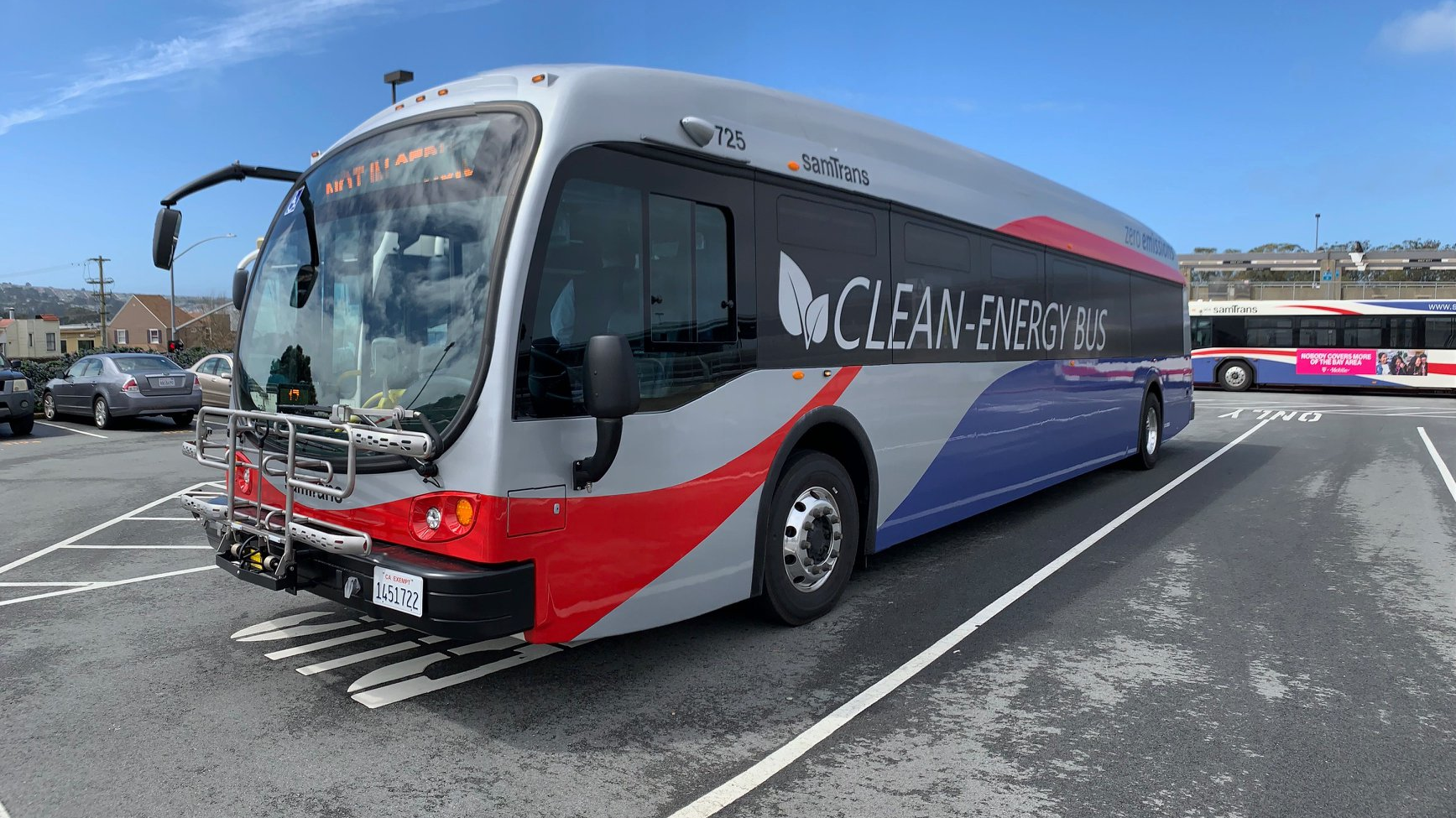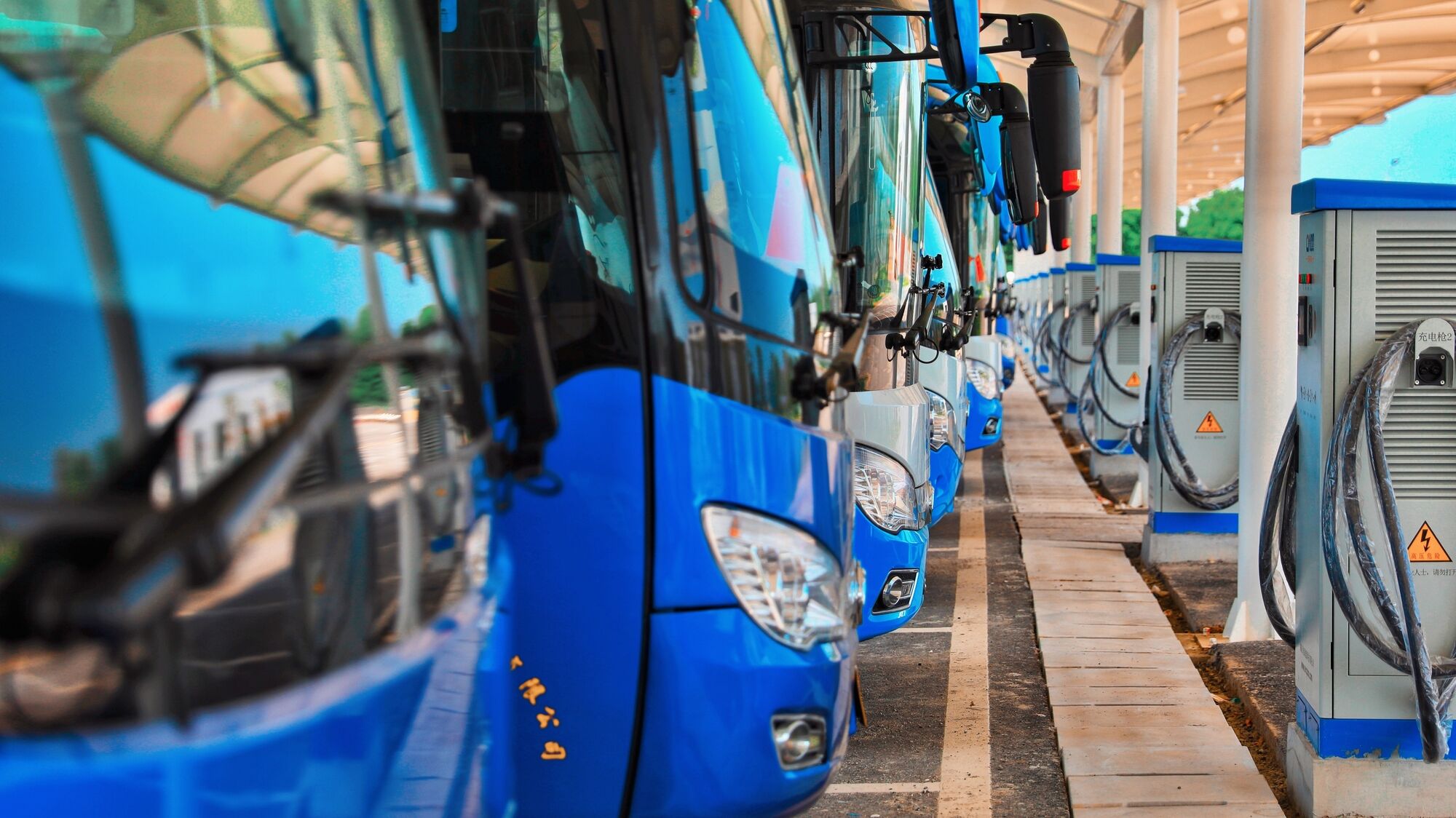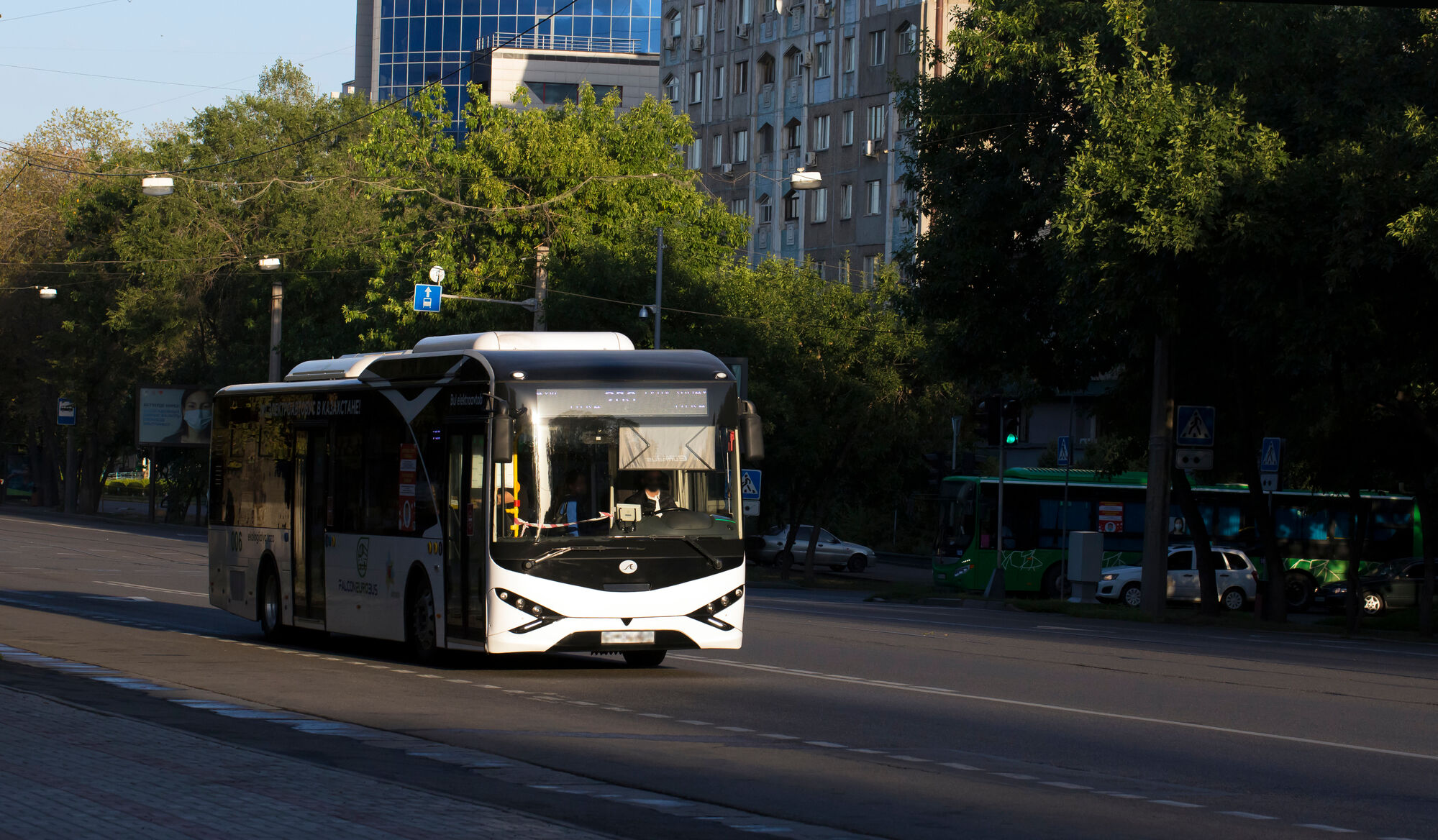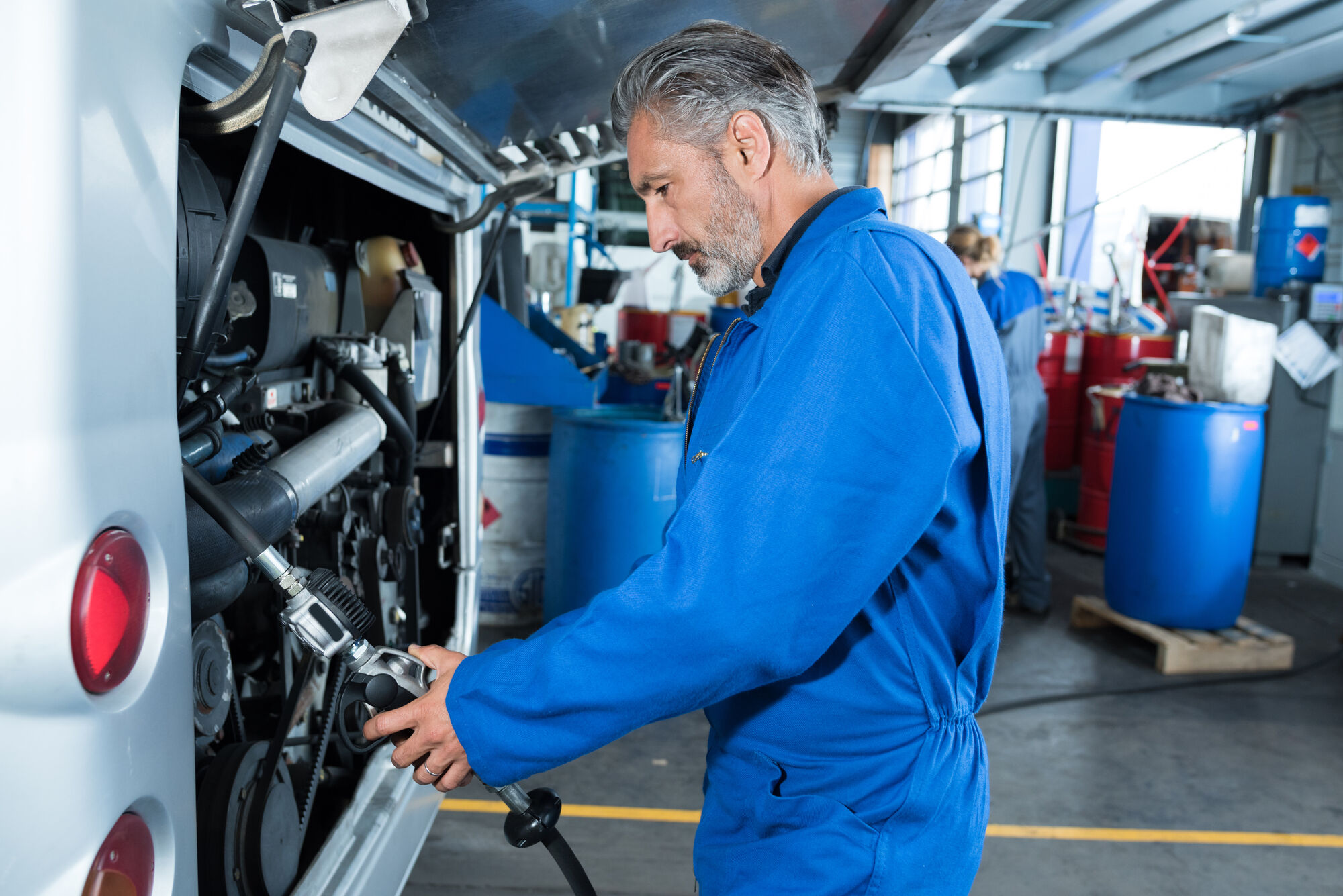
ABOUT SCOTT FRANKLAND
Scott Frankland is Head of Content at Sengerio. His spirit of inquiry leads him to the world of transportation and mobility to connect with the industry’s leading experts and shine a light on the hot topics.

San Mateo County Transit District, the Californian-based public transit agency more commonly known as SamTrans, is speeding ahead in the race to have a zero-emission fleet.
In July 2022, the agency replaced 30 diesel buses with 20 battery electric buses (BEB) and 10 Hydrogen-fuel cell electric buses (FCEB), shredding 6 years off the planned full conversion of its fleet from the previously projected 2040 to 2034.
Another 36 BEBs will be delivered between July 2023 and December 2024 with the first 10 FCEBs expected to be delivered in July 2023 and another 9 FCEBs delivered by January 2024.
Having completed its initial testing, the first New Flyer Battery Electric 40’ bus is expected to go into service by mid-May of 2023 following training for maintenance, operators, and First Responders. During this time, the agency will be commissioning the first 10 chargers.

From a more general perspective, the agency’s aggressive plan to electrify its fleet represents one of the many public transport providers looking to reduce their carbon footprint across the globe.
The process of transitioning to electric vehicles requires meticulous planning in order to analyze the different aspects a transport provider needs to consider before putting a plan into action.
In this article, Sengerio caught up with the team at SamTrans to understand how their strategy for electrification has made them stand out. More specifically, this article aims to provide insight to transport providers, both private and public, hoping to join the likes of SamTrans in the quest for zero-emission transport.
Given the many novel challenges that transport providers face when electrifying their fleet, there are several factors they need to consider when introducing revolutionary technology into an existing network of transportation services.
This includes analyzing the characteristics of electric vehicles and how they compare to the current fleet, as well as the routes they run and the distances they cover.
For instance, would electric alternatives be able to cover existing routes? Or would the routes have to be restructured to accommodate the requirements of the electric vehicles (battery power, available charging infrastructure, etc.)?
These are some of the considerations transport providers need to consider before switching to electric.
Therefore, it’s important to establish a plan that outlines the steps needed to transition from traditional buses to electric ones. This includes a timeline for purchasing and deploying electric buses, the installation of charging infrastructure, as well as the other points mentioned in this article.

While there’s never going to be a one-size-fits-all electrification plan, there are certainly some common factors every transport provider must consider.
One factor is the operating environment, where careful consideration should be given to understanding how elements such as terrain (gradability) and temperature are critical to maximizing the performance of an electric vehicle.
Variables such as operating over hills and the speed of service affect energy consumption and range of an electric vehicle. With BEBs, for example, freezing temperature causes them to suffer a greater loss of range.
Moreover, there are also infrastructure requirements that are crucial to a successful plan, as the team at SamTrans pointed out —
“Infrastructure requirements are vastly different and require careful consideration before a vehicle technology can be selected. For example, consider the following:
- The geographical location of the infrastructure.
- What is the timeline for implementing the fleet conversion? Engineering, design, and construction vary substantially with each technology.
- What are your operating parameters? Do you need rapid charging or fast fueling?
- What are the environmental considerations and clearances needed for each technology being considered?
- What type of facility modifications are required?
- What technical support may be required with the technology, for example, a charge management system, telematics, etc.”
Once the plan has been drawn up, providers can then start looking at which electric bus best suits their operations.
San Mateo County straddles the stretch of the peninsula between San Francisco and San Jose and is home to some of the area’s hilly terrain.

Because of this, one of the primary concerns for SamTrans when acquiring its electric vehicles was whether an electric alternative would have the capacity to fulfill the services that their traditional vehicles usually do.
“The first issue that most people consider is the range of the buses. Battery electric buses have a shorter range, approximately 100 miles less than a hydrogen fuel cell bus. BEBs also require a longer time to charge their batteries and therefore one must account for in-route charging to extend the range, or add rapid chargers and/or assume you’ll make route changes that fall within the bus range (mileage).
At the time of purchase, BEBs must be configured to the desired operating environment. FCEBs, on the other hand, provide operational flexibility similar to a diesel or CNG bus. Fueling can be performed at a central location within a very reasonable time, thus not necessitating route modifications.”
Having selected two typologies of electric vehicles, the agency has been able to determine which is better equipped to directly substitute its already existing routes via a system performance evaluation.
This type of evaluation can be conducted to determine the vehicle’s mileage per route. As a result, these data can inform operators as to which routes fall within the range of the zero-emission bus that’s being considered, as well as identify the need for additional vehicles and charging infrastructure. As SamTrans explains —
“These new buses are designed to operate in the same environment as diesel or CNG buses. One must consider that BEBs have a maximum range of 200 miles and FCEBs have a maximum range of 300 miles, in normal operating environments (mild temperature, level terrain).
Because we are deploying BEBs and FCEBs, should we discover one technology has an advantage over the other on particular routes, we will take that into consideration when assigning vehicles to those routes.”
The meticulous planning and testing by the agency when it came to selecting its desired electric vehicles ties into the fact that it can directly substitute its current fleet with electric alternatives.
In the longer run, the agency has saved a great deal of time that would have been spent redesigning its routes and operations.
Another challenge brought to the table is ensuring the right charging infrastructure is in place to support electric vehicles.
This includes installing charging stations at bus depots and even along the routes, which require transport providers to work with local power companies to assist in their transition.

SamTrans continues its collaboration with PG&E, California’s local gas and power company, to determine the best way to provide power to the necessary infrastructure at their bases where, for the time being, its charging and fueling will be done.
As the project expands, the agency will look to utilize charging stations outside of its bases in the hope that governing transportation bodies can create a more robust transport network that ultimately provides the necessary infrastructure —
“The District will evaluate partnerships with other agencies at intermodal locations for rapid chargers if the service demands warrant the option to add range while buses perform services. Based on our facilities locations, service demands, and opportunity for charging and fuel, infrastructure will be deployed at existing District facilities.”
By evaluating the characteristics of electric vehicles, transport providers can already create a picture of the charging requirements they’ll need. With BEBs, for instance, it is estimated that it will take between 4 – 6 hours to charge depending on the state of the battery when the bus returns to the depot.
SamTrans has invested a great deal of time in understanding the dynamics of its new technology and how it should go about managing how its vehicles are to be recharged. One way in which the agency will optimize this is by the use of energy management software.
“How much charge and when to charge is critical to understand. The rate of charge (how much energy) and the time of day will determine the cost and availability of the energy needed. Hence, having the software to monitor the state of charge and match the optimum energy rate (off-peak) is important to manage operating costs and vehicle availability.”
Utilizing software operates as the primary notification of problems with an electric vehicle, so choosing the right software to manage an electric fleet is crucial for smooth operations.
Efficient software allows transport providers to monitor the parameters of key systems, whether functional or operational.
In SamTrans’s case, both BEBs and FCEBs will be equipped with telematics systems to provide real-time monitoring, state of charge, and energy performance data. This helps to ensure that any problems with the vehicle are quickly identified, and the necessary actions are taken promptly.

In addition to telematics, energy management software can be used to manage the charging infrastructure. This software optimizes charging times and vehicle availability by considering factors such as the time of day and the rate of charge —
“We are considering energy management software to manage the charging infrastructure. The software is an optimization tool that considers the time of day, and rate of charge, to optimize charging times and vehicle availability.
We will use this software to ensure buses are efficiently charged. In the absence of monitoring software, the energy level of each bus would need to be documented, and calculate the time required for a full charge.”
Choosing the right digital tools is critical in managing zero-emission fleets. This is because properly equipped and monitored vehicles, along with optimized charging infrastructure, can help increase uptime and reliability while reducing operational costs.
The cost of electrifying a fleet can be daunting, so transport providers need to consider financing options.
While the initial cost is higher, electric vehicles have lower operating costs compared to diesel or gasoline buses, require less maintenance, and have lower fuel costs. So, over time, the savings can help offset the initial purchase cost of electric vehicles.

On top of that, governments across the globe are pressing hard on the accelerator to make transportation greener. As a result, they offer many incentives such as tax credits or grants to encourage fleet electrification. Transport providers can take advantage of these incentives to help with the high upfront cost of purchasing electric buses.
Given that SamTrans is a public transit agency, it took advantage of such incentives to ignite its sustainable transport plan —
“Cost is always a challenge for major efforts such as this one. Thankfully, both the State and Federal government have seen the importance of moving buses away from diesel and towards a more sustainable model, and their support is making the transition much easier than it otherwise would be.”
Despite the numerous advantages electric buses bring to the table, the nature of this new technology requires different maintenance procedures than traditional buses.
For example, the losses from fires involving battery electric vehicles can be greater than for conventional vehicles. This is due to the additional electrical components that can explode when ignited. Therefore, it is essential for transport providers to adequately train their personnel for when incidents may occur.

Providers should invest in enhancing the training of drivers, engineers, and technicians to detect vehicle and maintenance concerns, as well as establishing a clearly defined standard operating procedure. As the team at SamTrans explains —
“Education and training is another consideration in the timeline for this project. Those who will operate, maintain, or need to respond/assist in the event of an accident, must be trained appropriately to ensure the continuity of the service, but also to maximize the value of these new assets.
With the new technology, the agency will need to develop and implement new standard operating procedures (SOPs) and quite possibly a different reporting structure.”
With the new electrified services coming into effect this year, SamTrans is excited to share its sustainable transport ambitions with its passengers.
The agency plans to continue growing its ridership, despite already having one of the best ridership recovery rates in the San Francisco Bay Area. Moreover, the agency is looking forward to sharing its results with other peer agencies to support their efforts in achieving zero-emission transport —
“When these new vehicles will enter into service we’ll be eager to see the excitement and benefits of zero-emission technology firsthand. Having these modern, zero-emission vehicles will underline the importance of transit in the battle against climate change, and improving the air quality in our community.
The lessons we learned will be shared with other peer agencies to support their efforts. As transit properties in the Bay Area, we pride ourselves in collaborating and sharing experiences with others in our industry.”
This article has looked at the fundamental components of what makes a solid fleet electrification strategy, using SamTrams’s story as an inspiration to fellow transport providers who are also striving for zero-emission services.
Sengerio would like to thank the team at SamTrans for sharing its electrification story and we wish them all the best in their quest to improve transport and local communities.

ABOUT SCOTT FRANKLAND
Scott Frankland is Head of Content at Sengerio. His spirit of inquiry leads him to the world of transportation and mobility to connect with the industry’s leading experts and shine a light on the hot topics.

ABOUT EDOARDO ZACCARIA
Edoardo is the Sengerio Customer Success Manager and a passionate climber. His interpersonal skills and ability to build strong relationships have been invaluable in helping customers successfully get the most out of the Sengerio platform.